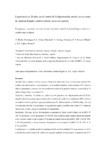Experiencia de 20 años en el control de la hipertensión arterial en un centro de salud en España: control estricto versus no estricto

View/
Use this link to cite
http://hdl.handle.net/2183/35671Collections
- Investigación (FFISIO) [475]
Metadata
Show full item recordTitle
Experiencia de 20 años en el control de la hipertensión arterial en un centro de salud en España: control estricto versus no estrictoAlternative Title(s)
Twenty-year experience in strict versus non-strict control of arterial hypertension in a health center in SpainAuthor(s)
Date
2023-09Citation
Muíño-Domínguez D, Gómez-Sánchez L, Gallego-Fernández V, Seoane-Pillado T, López-Álvarez XL. Experiencia de 20 años en el control de la hipertensión arterial en un centro de salud en España: control estricto versus no estricto. Semergen. 2023 Sep;49(6):101999.
Abstract
[Resumen] Introducción y objetivos. En los ensayos clínicos la reducción eficaz de la presión arterial (PA) produce una disminución de la incidencia de la morbimortalidad cardiovascular (CV). Nuestro objetivo principal es conocer si en las condiciones reales de la práctica clínica el control de la PA reduce a largo plazo los eventos CV.
Pacientes y métodos. El estudio se realizó en 164 pacientes con hipertensión arterial (HTA) elegidos entre los pacientes que acudían a las consultas de medicina de familia por HTA. Se hizo un análisis entre los pacientes que presentaban una PA clínica inferior a 140/90 mmHg y los que la tenían más elevada. Los pacientes se seguían hasta que se producía un evento CV o hasta un máximo de 20 años, en que se finalizaba el seguimiento.
Resultados. Del total de los 164 pacientes alcanzaron un buen control clínico de la HTA 93 (56,7%) pacientes y no lo alcanzaron 71 (42,2%). En el análisis multivariante quedó únicamente como variable predictora de eventos CV la falta de control estricto de la HTA (HR: 2,93; IC 95%: 1,45-5,89; p = 0,003), y el sexo femenino fue protector para eventos CV (HR: 0,37; IC 95%: 0,18-0,74; p = 0,005)
Conclusiones.
La variable predictora fundamental de morbimortalidad CV en pacientes con HTA es la falta de control estricto de la HTA; las mujeres también tuvieron menos complicaciones CV. [Abstract]
Introduction and aims: During clinical trials effective reduction of blood pressure (BP) leads to a reduction in the incidence of cardiovascular (CV) morbimortality. Our main aim is to ascertain whether, under actual conditions of clinical practice, BP monitoring leads to a long-term reduction in CV events.
Patients and methods: The study was performed on 164 patients with hypertension (HT) selected among patients who came to family medicine consultations because of HT. An analysis was performed between patients who presented clinical BP lower than 140/90mmHg and those that had higher levels. When patients entered the study, they were followed up until a CV event occurred or up to a maximum of 20 years, at which time follow up ended.
Results: Of the total of 164 patients, good control of BP was attained by 93 (56.7%), and 71 did not attain good control (42.2%). In the multivariate analysis, the only predictive variable for CV events was the lack of strict control of BP (HR: 2.93; 95% CI: 1.45-5.89; p=0.003), and the female sex was protective for CV events (HR: 0.37; 95% CI: 0.18-0.74; p=0.005).
Conclusions: The fundamental predictor variable of CV morbimortality in patients with HT is the lack of HT strict control; the women also had fewer CV complications.
Keywords
Presión arterial
Hipertensión
Seguimiento ambulatorio
Prevención primaria
Factores de riesgo
Blood pressure
Hypertension
Outpatient monitoring
Primary prevention
Risk factors
Hipertensión
Seguimiento ambulatorio
Prevención primaria
Factores de riesgo
Blood pressure
Hypertension
Outpatient monitoring
Primary prevention
Risk factors
Editor version
Rights
© 2023 Sociedad Española de Médicos de Atención Primaria (SEMERGEN). Publicado por Elsevier España
ISSN
1138-3593





